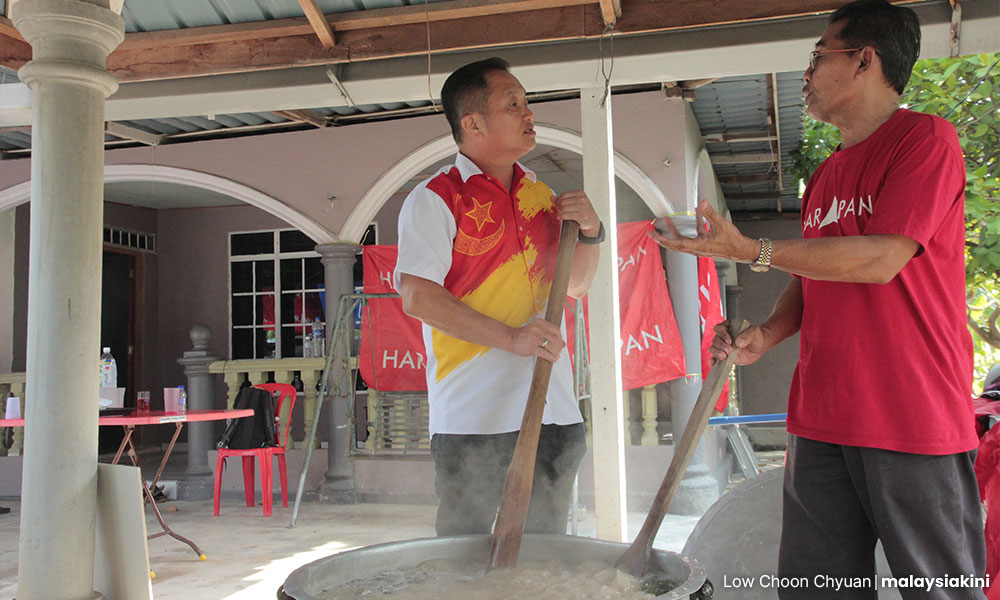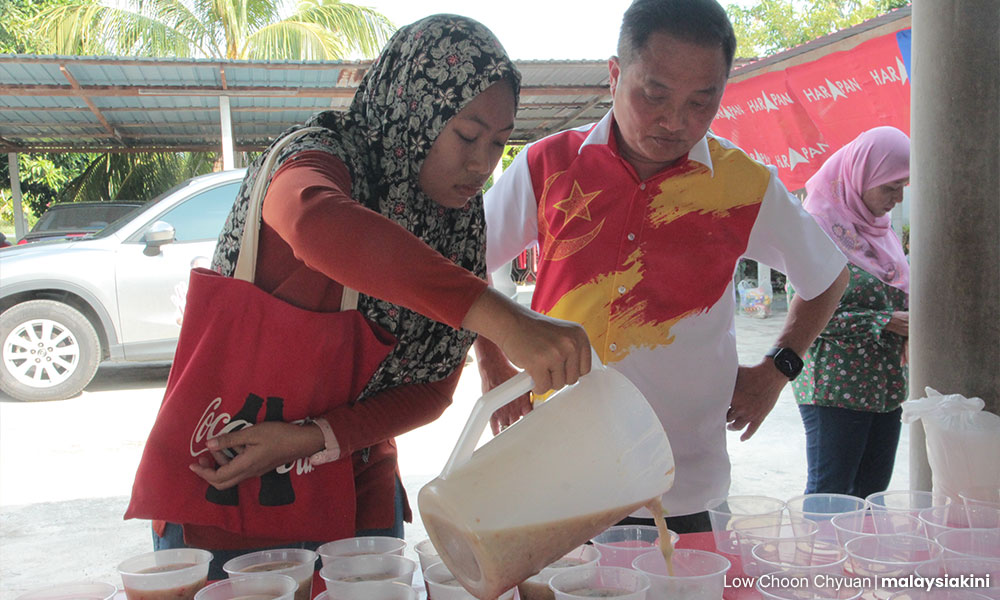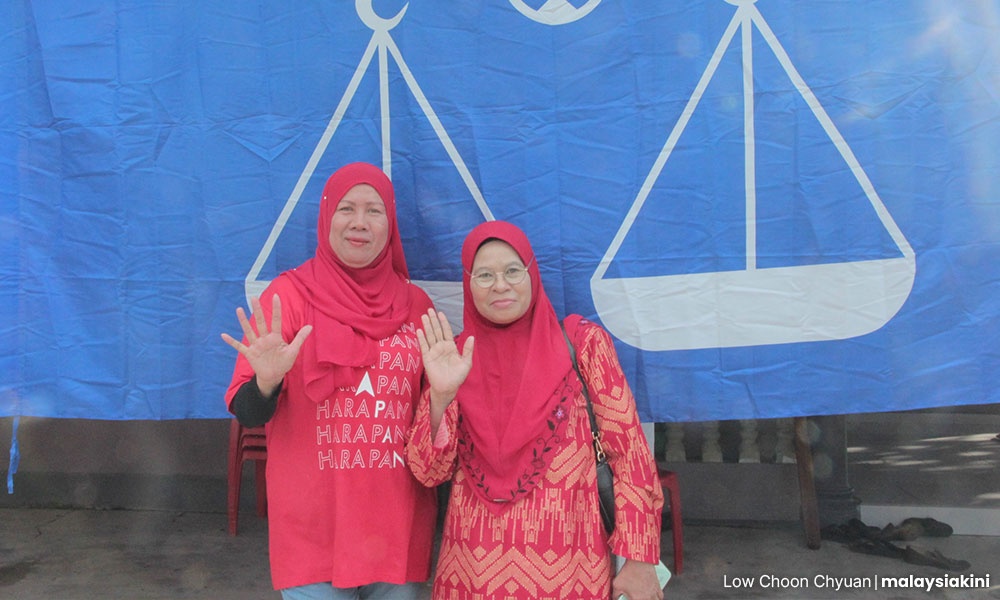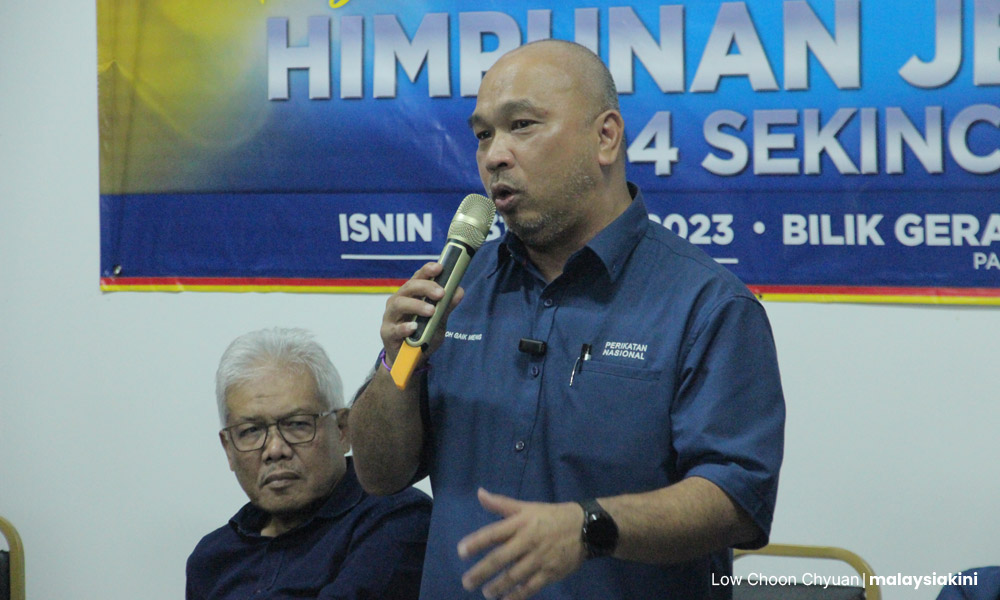STATE POLLS | DAP candidate Ng Suee Lim and his team dropped by a Malay village in Sekinchan on a Sunday afternoon to attend a cooking session of asyura porridge – a traditional Malay food.
After stirring the pot of porridge, Ng approached a table of around 10 Wanita Umno members who were preparing the ingredients.
The residents of Kampung Sungai Leman Laut are mainly of Javanese descent. Speaking to the villagers in Javanese, the incumbent Sekinchan assemblyperson asked if they had ever voted for him in the previous elections.
“Of course not, we used to vote for BN,” the villagers responded candidly.
Ng exclaimed, “So honest!” with a hearty laugh while slapping the table and joked that if the Umno members do not vote for him, he will complain to Sungai Besar Umno chief Jamal Yunos.
During the conversation, an Umno member came over to tease Ng, “YB, why do you keep chatting here, are you looking for a partner (cari jodoh)?” prompting laughter around the table.
This was a stark contrast to the past when the relationship between DAP and Umno was like fire and water.

After the 15th general election, the two parties formed a new alliance at the federal government, leading to the scene of Sekinchan Umno members joking about finding a spouse for Ng.
The new rapport signifies a window of opportunity for DAP – can they leverage the support of their new partner Umno to penetrate deeper into the Malay heartland and secure Malay votes, which DAP had been struggling with?
Not safe in Sekinchan Malay areas
Despite serving Sekinchan for four terms, Ng was still unable to win over voter support in Kampung Sungai Leman Laut, which used to be Umno’s stronghold. Instead, it seems that many villagers have shifted their support to Perikatan Nasional.
Kwi Ai Mei, a member of Ng’s campaign team, said that Ng has been working for the community for many years yet the support of Malay voters is low, pointing to the “Malay tsunami” in GE15.
“In one ballot box, we (Harapan) only received 30 votes, Jamal spent so much effort and got only 159 votes while PN won with 201 votes.
“Many people say that Sekinchan is a safe seat for DAP, they feel secure because they stay in Chinese areas, but if they come here, they will feel differently,” she added.
Kwi lamented that despite dedicated efforts to promote the cooking event, only about 20 members from DAP and Umno branches attended the programme.

The large pot of porridge was eventually packed into plastic containers for the members to distribute to their neighbours.
Focus on own voter base
Sekinchan has traditionally been known as a DAP stronghold, with 51 percent of Chinese voters and 43 percent Malay.
In GE15, Harapan gained 51.89 percent of the votes in Sekinchan while BN and PN’s candidates received 24.32 percent and 23.35 percent respectively.
An analysis of GE15 voters data found that, even if 70 percent of BN votes shift to PN and only 65 percent of Harapan’s voters in GE15 turn out to vote, Ng can win if he secures the remaining 30 percent of BN votes.
However, if the turnout rate of Harapan voters is lower than 65 percent while fewer than 30 percent of BN supporters vote for Ng, he may lose to PN candidate Goh Gaik Meng.
Ng himself admitted that it is still difficult for him to gain Malay votes, despite his new BN allies.
“The Malay constituencies are a tough nut to crack. They might be friendly with you, but they haven’t been voting for us all along,” he said.
Many of the Umno members he had met were relatively older, he said, and the voting patterns of younger Malay voters who are away from their hometown remains uncertain.
“We still have to rely on our core base. After all, it’s the first time cooperating with Umno and there is still a bit of concern. We don’t know if the voters will be influenced by PN at the last minute,” he added.
As such, Ng frequently signalled the urgency for voters to come back to Sekinchan to cast their ballot in hopes of a higher turnout rate.

In the first campaign week, Ng went door to door in Chinese villages to greet the voters.
“The ‘Green Wave’ is very strong, don’t forget to vote. Make sure to call your children to come back to vote,” he told them.
Sekinchan has over a thousand young voters aged 18 to 20, which make up 4.58 percent of the total population – a significant factor that should not be underestimated.
Future crisis for DAP?
In his campaign, Ng repeatedly mentioned changes in the voter population of Sekinchan, specifically with Malay voters increasing from 43 percent to 47 percent, while Chinese voters decreased from 53 percent to 51 percent.
This implies a more profound concern for DAP, especially for leaders like Ng contesting in mixed constituencies. Because the party may no longer be able to rely on its winning formula of relying solely on Chinese votes as the voter demographic gradually shifts.

“I believe there will definitely be some breakthroughs in getting Malay votes this time… A crisis can also be an opportunity. If it works well, in the future we can still win using this approach, even if there are more Malay voters.
“If Sekinchan becomes a Malay-majority constituency and no longer a Chinese-majority area in the future, yet we can still stand strong, that would be truly remarkable,” he said.
This could be the way forward for DAP, Ng said, and his battle in Sekinchan is meant to test the feasibility of this path.

Umno grassroots split
Noraini Teh is the Kampung Sungai Labu Umno chief and one of those responsible for coordinating the porridge-cooking event.
When the 51-year-old entered Ng’s office for the first time after GE15, she was nervous and thought, “If this were in the past, Jamal would have scolded me”.
Now, Noraini is a defender of the unity government, even reminding Umno members that the Harapan-led Selangor administration had many welfare policies such as free grocery shopping vouchers.
She admitted that these are good policies “but I am a BN member, I couldn’t say so previously”.
According to Noraini, the Kampung Sungai Labu Umno branch has 100 members and with her persuasion, 80 percent have agreed to vote for Ng, with the remaining 20 still undecided.

Meanwhile, Pekan Sekinchan Wanita Umno chief Sariah Ibrahim expressed concern as her branch is split 50-50 on voting for Harapan or PN.
“Some of the members say they can’t vote for the Chinese candidate from DAP but I asked, isn’t PN candidate Goh Gaik Meng Chinese?” the 58-year-old said.
Goh rides ‘Malay tsunami’
Goh, a former MCA Youth central committee member, joined Bersatu’s associate members' wing last March.
Bersatu associate members' wing chairperson Dr Chong Fat Full explained that Goh was fielded in Sekinchan due to the racial demographic of the constituency.
Though he did not spell it out, it was clear that they hoped to attract Malay votes by relying on PN’s brand while Goh is being used to win Chinese votes.
Even if Goh only attracts a small part of the Chinese votes, he may pull off a surprise win if the ‘Malay tsunami’ gains traction.
Therefore, they are targeting MCA hardcore supporters in the area who are dissatisfied with Harapan and DAP.
Although Goh is not a familiar face in Sekinchan, he has been highlighting local livelihood issues for the Chinese, such as land rights of Chinese new villages, the hardships of paddy farmers and abandoned pork stalls in the local market.

A villager who only wants to be known as Wong told Malaysiakini he is upset with Ng’s lack of action in dealing with the land deeds issue, even though he believes Ng does his job as an assemblyperson.
Despite that, it seemed this issue would not prevent them from voting for Ng.
“Although the land lease issue has made many people upset, without Ng, Sekinchan would not be where it is today (as a famous tourist spot),” another villager said on condition of anonymity.
As long as Chinese voters continue to support Harapan and their turnout is high, Ng is expected to retain Sekinchan. His position will be more secure if he is also able to get the support of BN and Umno voters.



No comments:
Post a Comment
Note: Only a member of this blog may post a comment.